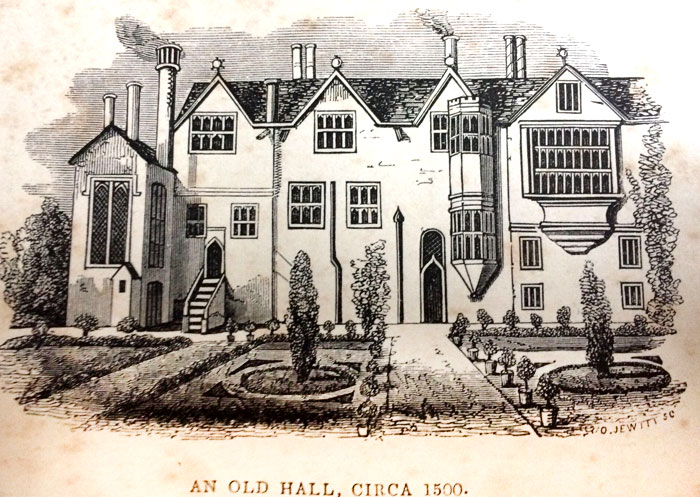Letheringham (Old) Hall, Suffolk. (1362-c. 1626-1708-1770). Letheringham and Goodwins Hoo (half a mile to north west) and The White House, Easton (half a mile to the east) for the purposes of this article are counted as one home.
Letheringham Manor and the moated Mansion of the Boviles came to the Wingfields in about 1362. when Margaret Bovile daughter & heir of Sir Thomas Bovile and widow of Sir William Carbonell of Badingham, Suffolk, married Sir Thomas Wingfield, younger brother of Sir John Wingfield of Wingfield, Chief of Staff of the Black Prince.
It must have been a vast house to cope with, in the 1440s, some 13 children (“the Elizabeth nee Fitzlewis brood”, 5 were knighted) with the heir’s 16 children (“the Anne nee Touchet brood”, 9 were knighted) in the next, in the late 1470s. Sir John and Elizabeth died as late as 1481 and c.1499 respectively, so the house must have needed an overflow.
Henry VIII’s sister Mary, the late Queen of France, Duchess of Suffolk, godmother of Captain Edward-Maria Wingfield’s father (christening at Calais, 1513) was entertained there by the Wingfields, Sir Anthony Wingfield (who was to become her brother’s Vice-Chamberlain etc.), when Mary wrote a letter from “Letheryngham” on Sep.9,1516 and in another letter dated Sep.28,1516 to Henry VIII, Mary refers to a visit she made to Letheringham Hall. [Jocelyn R. Wingfield, Virginia’s True Founder, p.10; P.C. Rushen, Transcripts of the Parish of Letheringham, 1901].
According to Chapman, the Wingfields held Letheringham Hall “of Charles Brandon, Duke of Suffolk” as opposed to “of Henry VIII”. [H. Chapman, The Sisters of Henry VIII, 1969, 192-3]. Lived in by the I lead of the Family until around 1628 presumably, when Sir Anthony Wingfield moved to Goodwins. Sold in 1708.
 The moated site of Letheringham Hall survives well and retains good archeological evidence, including the revetment of the inner face of the moat, for the important medieval house which once occupied the central platform. Further evidence for medieval and post-medieval occupation will be contained in deposits on the island and information concerning earlier land use will be preserved in soils buried beneath the raised surface. It is a good example of a moat fed by water from an adjacent river and the low-lying situation contrasts with the hill-top location and very different character of the nearby moated site of Letheringham Lodge.
The moated site of Letheringham Hall survives well and retains good archeological evidence, including the revetment of the inner face of the moat, for the important medieval house which once occupied the central platform. Further evidence for medieval and post-medieval occupation will be contained in deposits on the island and information concerning earlier land use will be preserved in soils buried beneath the raised surface. It is a good example of a moat fed by water from an adjacent river and the low-lying situation contrasts with the hill-top location and very different character of the nearby moated site of Letheringham Lodge.
The historical link between these two sites and their connection with the locally and nationally prominent Wingfield family during the 15th and 16th centuries adds further interest.
The water-filled moat, which surrounds a central island raised 0.5m to 1m above the general ground level, is approximately 2.5m in depth and varies between 7m and 15m in width, with overall maximum dimensions of 75m north- east/south-west by 70m north-west/south-east. A short channel, at one time approximately 3m wide but now partly narrowed, leads from the river into the north end of the south-western arm. The south-eastern arm of the moat is crossed by a causeway which is faced with brickwork dated in part to the 15th or 16th century.
The south-eastern face of the island to either side of the causeway is revetted variously with flint and mortar, ashlar and brick, and the section of this revetment to the south of the causeway includes the projecting bases of two buttresses or turrets. Fragments of revetting survive also on the south-western face and at the northern end of the north-west side.
The causeway and the revetment and associated structures to the south of it, which together are listed Grade II, are included in the scheduling, as are all of the surviving revetment and the north wall of an outbuilding to the rear of the house, on the inner edge of the north western arm of the moat, which incorporates sandstone blocks. These structures remain as visible evidence of the important mansion which occupied the site during the 15th and 16th centuries and which was the seat of the Wingfield family, including Sir Anthony Wingfield, Vice-Chamberlain to Henry VIII and Comptroller of the Household to Edward VI.
The manor was held after the Norman Conquest by Geoffrey de Mandeville, by the de Glanville family and then the de Boviles from whom it passed to the Wingfields, following the marriage of Margery de Bovile to Sir Thomas Wingfield in the mid-14th century.